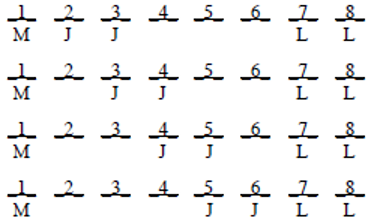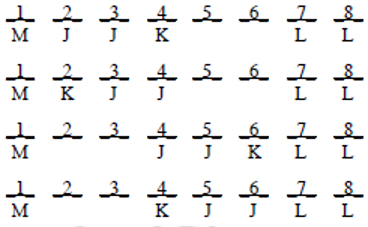The conditions “J and J are holding hands” and “L and L are holding hands” are naturally symbolized as JJ and LL, respectively. The condition “K and K are not holding hands” can be symbolized as K...K. [The symbol ~(KK) would also work well, but the symbol K...K is more descriptive because it shows the space between the Ks.] The condition “One of the Ls is at one end of the line, and one of the Ms is at the other end” can be symbolized as L=1st/last and M=1st/last. The diagram will consist of eight dashed lines numbered 1 through 8, from left to right:
JJ
LL
K ... K
L = First / Last
M = First / Last

No significant conditions can be derived from the given information, and no conditions can be placed on the diagram. So we attack the questions.
We will consider only the diagram with M at the left end and the Ls at the right end. The diagram with the Ls at the left end and the M at the right end is the mirror image, so it will generate the same answer. There are four possible diagrams, one for each of the four possible positions of the condition JJ:

From the condition K...K, we see that in the first diagram there must be a K in position 4, in the second diagram there must be a K in position 2, in the third diagram there must be a K in position 6, and in the last diagram there must be a K in position 4:

Each of these diagrams has a J next to a K. In other words, at least one J must be holding hands with a K. Hence the answer is (A).